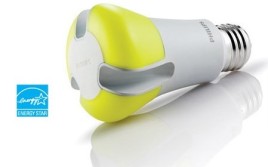Transcript
Research is changing the way we think about energy efficient electronics. This podcast, from the coalface of electronics and materials research, is produced and presented by Dr Radu Sporea of Surrey University’s Advanced Technology Institute. It looks at the work currently being undertaken on the new generation of energy efficient lighting – used not just in lighting rooms, but in screens for our electronic devices.
This is the fourth in Radu’s occasional series from the Institute. See also:
- New frontiers in electronic engineering
- Solar technology: harnessing the power of the sun
- The future of electronics is flexible
Dr Radu Sporea: A great advantage of podcasts and audiobooks is that you can still enjoy them after lights-out. But light is an essential ingredient for most active human pursuits. Early members of our species prolonged their hours of activity by burning things in order to imitate sunlight. Even back then they kept an eye on energy efficiency as some things burned less well than others. In the 19th Century pioneers like Joseph Swan and Thomas Edison successfully harnessed electricity and used it to heat up materials until they glowed white hot. For more than a century, incandescent bulb technology has been *the* way to light a supper (and for that matter a fancy dinner soiree).
But in 2011, the L-Prize for efficient lighting showed that we can do a lot better. The winning design by Philips, a long-standing expert in all things lighting, is six times more efficient than a conventional bulb and a third more economical than energy-efficient bulbs.
for efficient lighting showed that we can do a lot better. The winning design by Philips, a long-standing expert in all things lighting, is six times more efficient than a conventional bulb and a third more economical than energy-efficient bulbs.
By heating up materials or burning them in an attempt to produce light, we waste a lot of the energy as heat. Efficient light generation, as the prize-winning approach shows, relies on semiconductors. Dr Lynn Rozanski is a Research Fellow working on efficient energy conversion. She explains:
Lynn Rozanski Semiconductor materials have a property that allows them to emit light when electricity is passed through them in a certain way.
Light emitting diodes or LEDs are electronic devices which allow us to control the intensity of the light coming out by the amount of electrical energy we feed into them.
They are efficient because a larger proportion of the energy gets converted to light than in conventional bulbs.
Wavelength. Depending on material properties we get certain colours of light.
RS: Efficient generation of coloured light is all well and good, but rare are the instances when a deep red ambiance is all that’s required. White light, which resembles the sun’s rays is the most versatile and most desirable. So how do we create white light?
Lynn Rozanski White light is in fact composed of a multitude of colours. The sun’s white light contains all colours of the rainbow mixed together. But we can cheat and create good-enough white light by mixing yellow and blue.
So a trick we sometimes use is to use a blue LED together with a material called a phosphor which converts some of the blue light to yellow. The yellow mixes with the remaining blue to appear white.
RS: Organic semiconductors can be much cheaper to make into electronics through their ability to be processed from a liquid state. Are they any good at producing light?
Lynn Rozanski Some materials are very good at producing intense, coloured light. We can definitely use them as light emitters.
But they are not terribly energy efficient, so the amounts of light they produce are not great. There’s a way still to go until they can be used in general lighting.
One could envisage, though, ambient or mood lighting which can change colour subtly – made on large area flexible panels like wallpaper – very cheap.
RS: But coloured light emitters have another, very useful application: display screens. Organic light emitting diodes or OLEDs are starting to be used in palm-sized screens as a consequence of their improved energy efficiency.
Conventional displays use liquid crystals which act as taps or valves for light coming from a white backlight. Different colours are generated by directing more or less white light through colour filters using these liquid crystals. When the displayed image is dark, the liquid crystal valves are mostly closed so little light gets through, but the white backlight is still shining at full power – not very efficient use of generated light. In OLED displays, the light emitting diodes produce just the amount of light required to display a certain image. A dark picture will draw a lot less power than a completely white one, and as most scenes are not even 50% bright, significant energy saving is possible.
OLED Display screens are arrays of millions of red green and blue LEDs. These light emitters are small enough so that when viewed from a distance, the light they produce blends and by varying the proportion of red, green and blue light coming from LEDs placed close-together we can display any colour. But this raises some problems in the long run. Dr Chris Mills is working on improving the performance and robustness of organic light emitting diodes:
Chris Mills The materials that produce red, green and blue light age at different rates. This means that in time, a display screen will not only lose brightness, but it will develop a coloured tint, as blue emitters become weaker faster and produce proportionally less colour than the red and green.
Commercial display manufacturers get around this by incorporating complicated feedback circuits that adjust for this problem, but this increases the cost of the display.
The display’s efficiency reduces over time as more and more energy needs to be expended to produce the same amount of light from the aging semiconductor material.
Over the past decade, OLED technology has progressed very rapidly, but it seems that OLED lifetime and energy are still to be improved. Judging by the enthusiastic activity I witness around me in the lab, many improvements are still to come.
Chris Mills: We are putting a lot of work making these devices more efficient and long-lived. We can do this by designing new semiconductor materials, but we can also improve the structure of our devices.
Organic semiconductors are generally degraded by contact with oxygen or moisture, which means that before we can use them in the real world, circuits need to be encapsulated in air-tight transparent containers, which adds to the fabrication cost.
This applies equally to organic LEDs for displays and lighting, so there is a drive to improve these properties.
RS: High-performance LEDs for lighting are progressing in leaps and bounds, as the ultra-efficient L-Prize winner shows. But finding a way of fabricating them cheaper is the next challenge, as not many people will see the cost-saving benefit of buying light bulbs at £20 apiece.
If semiconductors can be used for producing light by drawing electrical energy, could they be used conversely for making electricity from sunlight? The International Space Station, countless communications satellites and an array of government-backed generate-your-own electricity schemes says they can, but not always without difficulty.
Tags: Electronic engineering, Energy efficient lighting, sustainable energy



Subscribe with…